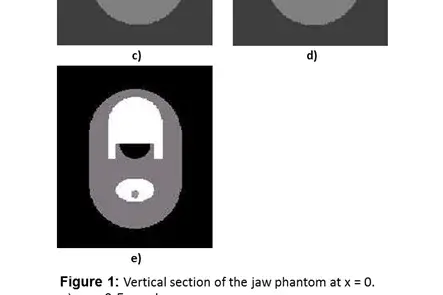Jaw Phantom
Oliver Watzke
An anthropomorphic jaw phantom is used to examine artifacts that occur in the region of the lower half of the head, especially those resulting from the high number of objects with high density and from metallic implants (crowns). A low contrast object in the tongue region serves to judge the detectability of cancers in this region.
Phantom Description
The phantom has been designed to display the most important structures in the jaw region with a minimal number of simple geometrical objects. It has a height of 10 cm and a cross section of 12-18 cm. The neck is a cylinder with cylindrical trachea and spine. While the trachea has a circular cross section the spine's cross section is elliptical and it is subdivided into vertebras. At the chin the neck abruptly meets the oval head. The jaw consists of a lower and an upper part with two rows of teeth and a small gap in between. The trachea opens into a wider oval throat and mouth that is bounded by the tongue and the roof of the mouth above which the nose begins. Among the 32 teeth 3 molars are replaced by crowns and one is removed so that a gap is left. In the tongue region a spherical low contrast object is inserted representing a cancer. The densities are as follows:
• body tissue: 1 (equivalent to water)
• bone (jaw, spine): 2
• bone marrow: 1.1
• teeth: 1.2
• golden crowns: 19.3
• tongue cancer: 1.01
Files
